ABSTRACT
In Shizuoka prefecture, Japan, farmers traditionally cover furrows in green-tea fields with grass (mainly Miscanthus sinensis and Pleioblastus chino) in the autumn and winter seasons. The semi natural grasslands from where this grass is collected are called Chagusaba. The results of analyses carried out by aerial photography and using GIS at Higashiyama area in Kakegawa city show that 65% of the area of a tea field is maintained as semi-natural grassland. This fact is interesting because, in Japan, the area covered by semi-natural grassland is decreasing, and some natural plants found in semi-natural grasslands are now endangered. In contrast, Chagusaba provides an important habitat for natural plant species of semi-natural grasslands. Thus, Chagusaba is considered as a good example of traditional cultural landscape and biodiversity conservation maintained by agricultural cultivation. May 2013, traditional tea-grass integrated system in Shizuoka was accepted as a Globally Important Agricultural Heritage Systems (GIAHS). This registration as GIAHS had agricultural promotion and economic ripple effect in the local region. The traditional tea-grass integrated system can be said to balance tea production with biodiversity, and utilize atoyama resources for high-value-added farming. It is an interesting case study in considering the future of agriculture.
Keywords: biodiversity, traditional tea farming, semi natural grasslands, globally important agricultural heritage systems (GIAHS), new agricultural promotion
INTRODUCTION
What is Chagusaba?
Semi-natural grasslands, especially Miscanthus sinensis (Japanese pampas grass), are now rapidly disappearing in Japan. In the past, grasslands in rural areas existed across vast areas and provided resources such as livestock feeds, fertilizers to maintain soil fertility in fields, and materials for thatched roofs. In 1880, these grasslands covered over 30% of the country and in 1950 (Ogura 2006), they covered over 10% of it, but now they cover only 3%. In Japan (Shoji 2003, Sprague 2003), the semi-natural grasslands of the satoyama that had been maintained by agriculture have not been the subject of much reflection, despite the fact that they are being depleted.
However, the tea producing areas of Shizuoka use cuttings of the Miscanthus sinensis, which is traditionally used on tea plantations, in order to produce high-quality tea. This is why semi-natural grasslands (Chagusaba) exist in large quantities there as a source of supplies (Figure 1). This could be thought of as an important satoyama semi-natural grassland that has been maintained through the agricultural activities of tea production (Inagaki et al. 2010, Kusumoto et al. 2010).
Here, I will share the results of research that explain how the semi-natural grasslands, which are known as Chagusaba and cultivated using the principles of agriculture, are established and maintained, while exploring the importance of Chagusaba from the point of view of biodiversity conservation.
The semi-natural grassland in Satoyama, which is maintained by agriculture
In modern rural areas where large areas of grasslands are being depleted, there are many smaller meadows being established that are not as vast as grasslands. For example, there are meadows on pond embankments (Kusumoto et al. 2007), meadows on levee (Ito and Kato 2007), meadows along small waterways(Ito and Kato 2007), meadows on slopes (Kusumoto et al. 2009, Kitagawa et al. 2004), paddy fields (Yamada et al. 2010), and fallow fields (Kusumoto et al. 2005). These are universally present in rural areas and play an important role as the habitat of grassland plants. In recent years, research has shown the importance of these meadows from a biodiversity conservation standpoint. These are smaller meadows that are managed secondarily as part of agricultural work.
There is also no doubt that Chagusaba are grasslands that are maintained through agricultural work. However, they have features that are more interesting than the meadows established around paddy fields. One such feature is that they are semi-natural grasslands that cover a much larger area than the small meadows in the areas around paddy fields. Another is that their natural resources are used in tea production. Chagusaba are maintained through the agricultural activities of tea production, and tea production is achieved through the resources gained from Chagusaba. Tea production and Chagusaba exist in symbiosis with each other.
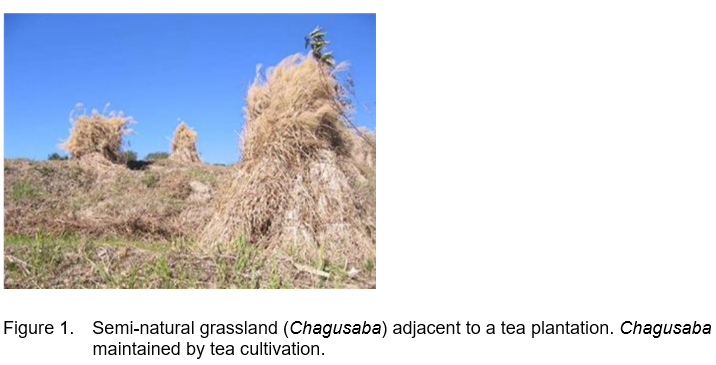
MATERIALS AND METHOD
Field studies were conducted in 2008-2010 in Higashiyama area of Kakegawa city, Shizuoka, Japan. Analyses were carried out using aerial photography of 1889, 1962, and 2007. Vegetation cover and height were measured for each plant species using quadrat method (1m square) in 50 Chagusaba (Braun-Blanquet 1928.). In addition, we collected the environmental gradient and management hearing data of each investigation point. The data were analyzed by multivariate techniques as Two-way indicator species analysis (TWINSPAN: Hill 1991) and Generalized Linear Models (GLM) as the variation partitioning.
RESULTS AND DISCUSSION
The relationship between Chagusaba and tea production
The cutting of grass, mainly Miscanthus sinensis on tea plantations, improves the flavor of the tea and improves the physical environment of the soil (Kato 1943). It is a farming method that has continued to be carried out traditionally.
Tea farmers cut the grass in Chagusaba between autumn and winter and let it dry out. The dried grass is laid in the furrows of the tea plantation (Figure 2). About 700 kg of dried grass is used for every 10 a of the tea plantation, and the time spent on this task accounts for about 60% of the total work time in this period (Saito et al. 2010).
Realities of Chagusaba distribution
We identified tea plantations and Chagusaba in aerial photographs taken in 2009 of the Higashiyama district of Kakegawa, Shizuoka, and conducted digital mapping. Then, using GIS, we calculated their areas and found that there were 182 ha of tea plantation and 130 ha of Chagusaba (Figure 3). It is clear that semi-natural grasslands are being maintained whose area is equivalent to 71% of the area of the tea plantation. In interviews with tea farmers, we also received many reports that, "the ideal proportion of tea plantation to Chagusaba is one-to-one, and in the past 1,000 kg of dried grass were spread on every 10a of tea plantation.”

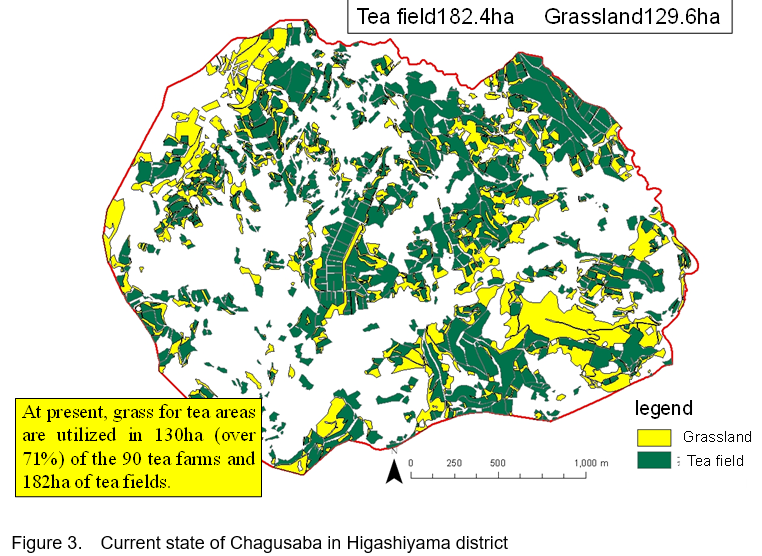
Classification of the vegetation type
Fifty Chagusaba were classified into five vegetation types by TWINSPAN (Table 1. Gr1 was dominated by Miscanthus sinensis, Gr2 by Pleioblastus chino. Gr3 was dominated by Miscanthus sinensis and Solidago canadensis which is invader plants, Gr4 was invaded by naturalized plants such as Solidago canadensis, and Gr5 was Gr5 was dominated by Miscanthus sinensis and characterized by less native plant species. We estimated Gr1 and Gr2 show a higher Simpson diversity index (H') than any other vegetation type. Furthermore, this observation demonstrates that certain endangered plant species such as Platycodon grandiflorum, Euphorbia adenochlora, and Cephalanthera falcate grow in Gr1- and Gr2-type.

Establishment and maintenance mechanism of Chagusaba
We took soil samples, and measured lighting, slope orientation and angles, and soil moisture at all survey sites. In addition, we interviewed the tea farmers about historical changes to the land and how it is managed.
The results showed that high number of native plant species Chagusaba had low soil pH, covered large areas, and were in places where the land had not been modified. These results indicate that they were not subject to disturbances that can damage flora. Through statistical analysis (GLM), we found that land modification had an especially significant effect on the diversity of native plants, and that the diversity of native plants was reflected in the history of the use of the land (Figure 4).
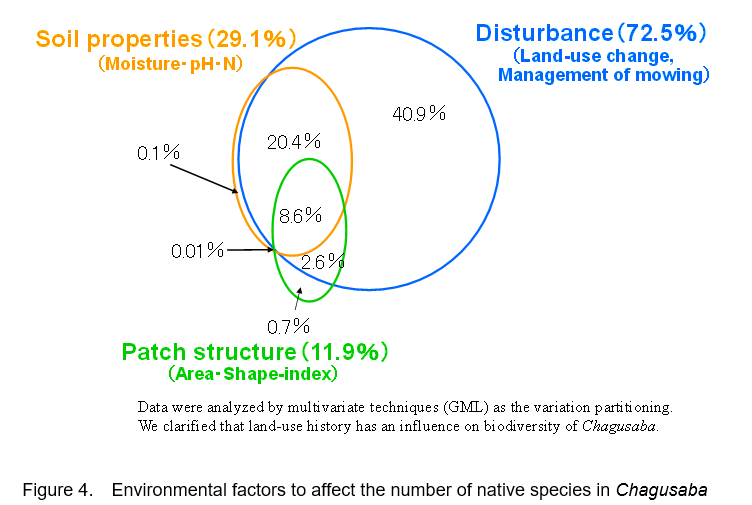
Registration to GIAHS and its ripple effects
These results of research that "biodiversity is maintained by Chagusaba and tea production coexists with nature," received high praise, and in May 2013, Shizuoka's Chagusaba farming method was accepted as a Globally Important Agricultural Heritage Systems (GIAHS), a list maintained by the Food and Agriculture Organization (FAO) of the United Nations. This registration as GIAHS had agricultural promotion and economic ripple effect in the local region. It led, for example, to the creation of a new tea brand (Fig 5), expectations for green tourism, and the launch of the "authentication of Chagusaba farmers." In the future, it is expected that regions that had abandoned the traditional tea-grass integrated system because it was hard work may revive the method.
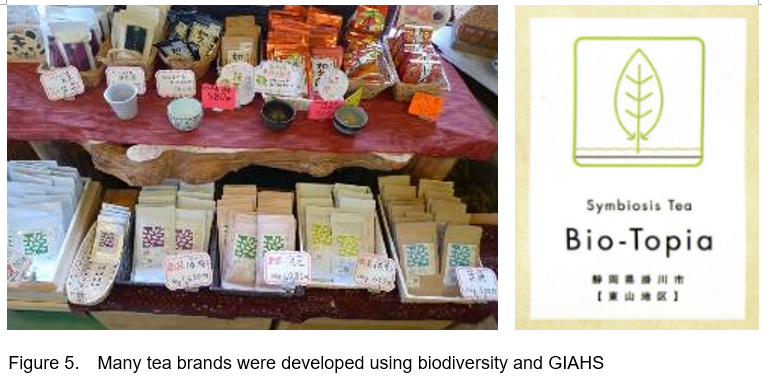
CONCLUSION
The seven flowers of autumn that are often spoken of as traditional signs of the fall in Japan (Miscanthus sinensis, Lespedeza bicolor var. japonica, Pueraria lobata, Eupatorium japonicum, Patrinia scabiosifolia, Dianthus superbus var. longicalycinus) used to be familiar plants seen in the rural satoyama of Japan. However, four of them have been listed as endangered or threatened species as the degradation of Japan's semi-natural grasslands have become significant. However, Chagusaba could be considered places where we can observe these important plants closely and in abundance. It has become clear that tea production plays a role in conserving the region's biodiversity.
The agricultural processes of tea production protect grasslands, and tea cultivation benefits from those grasslands. In this way, the traditional tea-grass integrated system can be said to balance tea production with biodiversity, and utilize satoyama resources for high-value-added farming. It is an interesting case study in considering the future of agriculture.
REFERENCES
Braun-Blanquet J. 1928. Pflanzensoziologie. Grundzuege der Vegetationskunde, pp865. Wien. 2. Aufl. 1951. Wien. 3. Aufl. 1964. Wien, New York
Hill M O. 1979. TWINSPAN-A FORTRAN program for arranging multivariate data in an ordered two-way table by classification of individuals and attributes, Ithaca, New York:Cornell University
Inagaki H and Kusumoto Y. 2015 Assessment of GIAHS in Shizuoka: The traditional tea-grass integrated system, Journal of resources and ecology, 5(4), 398-401.
Inagaki H, Kusumoto Y, Iwasaki N, et al. 2010. Biodiversity evaluation of ‘CHAGUSABA’; semi-natural grassland maintained by green tea cultivation, Proceedings of the 4th international conference on tea culture and science, 38-41.
Ito K and Kato K. 2007. Plant Species Composition of Semi-natural Grasslands in Yatsuda Paddy Field of Tochigi, Japan, Journal of the Japanese Institute of Landscape Architecture 70(5), 449-452. (in Japanese with English summary)
Kato H. 1943. Science of Tea,Kawade-Shobo,Tokyo,250pp
Kitagawa Y, Okubo S, Yamada S, et al. 2004. Species Composition and Species Richness of Herbaceous Vegetation on Lowermost Hillside-slopes in Hilly Yatsuda Landscape,Journal of the Japanese Institute of Landscape Architecture, 67(5),551-554. (in Japanese with English summary)
Kusumoto Y , Iwasaki N, Hiradate S et al. 2010. Historical change in Chagusaba: a semi-natural grassland maintained by green tea cultivation at Higashiyama area, Shizuoka, Proceedings of the 4th international conference on tea culture and science, 42-45.
Kusumoto Y, Okuro T, Ide M. 2005.The relationships between the management history and vegetation types of fallow paddy field and abandoned paddy fields : Case study of Sakuragawa and Kokaigawa river basin in Ibaraki prefecture, Journal of Rural Planning Association 24, 7-12. (in Japanese with English summary)
Kusumoto Y, Yamamoto S, Okuro T, et al. 2007. The Relationship between the Paddy Landscape Structure and Biodiversity of Plant Community in the Tone River Basin,Journal of the Japanese Institute of Landscape Architecture, 70(5),445-448. (in Japanese with English summary)
Kusumoto Y and Yamamoto S. 2009. Elucidating the mechanisms behind the high plant diversity in yatsu (valley floor) paddy field areas: how cutting grass around paddy fields helps to promote diversity, NIAES Annual Report 2008, 21-23.
Saito T, Sugiyama T, Akahori S, et al. 2010. Effect of the traditional tea-grass integrated system on soil carbon storage in Higashiyama, Kakegawa city, Abstract of tea research journal,71-72. (in Japanese)
Ogura J. 2006. The Transition of Grassland Area in Japan,Journal of Kyoto Seika University, 30,159-172. (in Japanese)
Shogi A. 2003. Grassland and Landscape Ecology : Landscape Ecological Studies for Semi-natural Grassland Conservation,Grassland Science, 48(6), 557-563. (in Japanese)
Sprague D S. 2003. Grassland and Landscape Ecology : Function and Spatial Structure of Grasslands in the Kanto Plain : Did "plains grasslands" exist?, Grassland Science, 48(6),,531-535. (in Japanese)
Yamada S, Kusumoto Y, Tokuoka Y, et al. 2010. Landform type and land improvement affect floristic composition in rice paddy fields from central Japan. Weed Research, 51(1), 51-62.
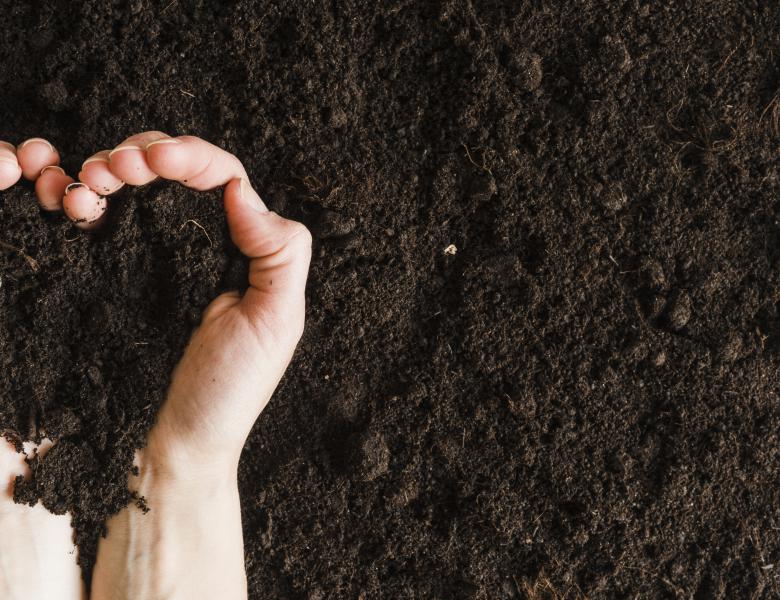


Biodiversity Maintained by the Traditional Tea-Grass Integrated System in Shizuoka, Japan
ABSTRACT
In Shizuoka prefecture, Japan, farmers traditionally cover furrows in green-tea fields with grass (mainly Miscanthus sinensis and Pleioblastus chino) in the autumn and winter seasons. The semi natural grasslands from where this grass is collected are called Chagusaba. The results of analyses carried out by aerial photography and using GIS at Higashiyama area in Kakegawa city show that 65% of the area of a tea field is maintained as semi-natural grassland. This fact is interesting because, in Japan, the area covered by semi-natural grassland is decreasing, and some natural plants found in semi-natural grasslands are now endangered. In contrast, Chagusaba provides an important habitat for natural plant species of semi-natural grasslands. Thus, Chagusaba is considered as a good example of traditional cultural landscape and biodiversity conservation maintained by agricultural cultivation. May 2013, traditional tea-grass integrated system in Shizuoka was accepted as a Globally Important Agricultural Heritage Systems (GIAHS). This registration as GIAHS had agricultural promotion and economic ripple effect in the local region. The traditional tea-grass integrated system can be said to balance tea production with biodiversity, and utilize atoyama resources for high-value-added farming. It is an interesting case study in considering the future of agriculture.
Keywords: biodiversity, traditional tea farming, semi natural grasslands, globally important agricultural heritage systems (GIAHS), new agricultural promotion
INTRODUCTION
What is Chagusaba?
Semi-natural grasslands, especially Miscanthus sinensis (Japanese pampas grass), are now rapidly disappearing in Japan. In the past, grasslands in rural areas existed across vast areas and provided resources such as livestock feeds, fertilizers to maintain soil fertility in fields, and materials for thatched roofs. In 1880, these grasslands covered over 30% of the country and in 1950 (Ogura 2006), they covered over 10% of it, but now they cover only 3%. In Japan (Shoji 2003, Sprague 2003), the semi-natural grasslands of the satoyama that had been maintained by agriculture have not been the subject of much reflection, despite the fact that they are being depleted.
However, the tea producing areas of Shizuoka use cuttings of the Miscanthus sinensis, which is traditionally used on tea plantations, in order to produce high-quality tea. This is why semi-natural grasslands (Chagusaba) exist in large quantities there as a source of supplies (Figure 1). This could be thought of as an important satoyama semi-natural grassland that has been maintained through the agricultural activities of tea production (Inagaki et al. 2010, Kusumoto et al. 2010).
Here, I will share the results of research that explain how the semi-natural grasslands, which are known as Chagusaba and cultivated using the principles of agriculture, are established and maintained, while exploring the importance of Chagusaba from the point of view of biodiversity conservation.
The semi-natural grassland in Satoyama, which is maintained by agriculture
In modern rural areas where large areas of grasslands are being depleted, there are many smaller meadows being established that are not as vast as grasslands. For example, there are meadows on pond embankments (Kusumoto et al. 2007), meadows on levee (Ito and Kato 2007), meadows along small waterways(Ito and Kato 2007), meadows on slopes (Kusumoto et al. 2009, Kitagawa et al. 2004), paddy fields (Yamada et al. 2010), and fallow fields (Kusumoto et al. 2005). These are universally present in rural areas and play an important role as the habitat of grassland plants. In recent years, research has shown the importance of these meadows from a biodiversity conservation standpoint. These are smaller meadows that are managed secondarily as part of agricultural work.
There is also no doubt that Chagusaba are grasslands that are maintained through agricultural work. However, they have features that are more interesting than the meadows established around paddy fields. One such feature is that they are semi-natural grasslands that cover a much larger area than the small meadows in the areas around paddy fields. Another is that their natural resources are used in tea production. Chagusaba are maintained through the agricultural activities of tea production, and tea production is achieved through the resources gained from Chagusaba. Tea production and Chagusaba exist in symbiosis with each other.
MATERIALS AND METHOD
Field studies were conducted in 2008-2010 in Higashiyama area of Kakegawa city, Shizuoka, Japan. Analyses were carried out using aerial photography of 1889, 1962, and 2007. Vegetation cover and height were measured for each plant species using quadrat method (1m square) in 50 Chagusaba (Braun-Blanquet 1928.). In addition, we collected the environmental gradient and management hearing data of each investigation point. The data were analyzed by multivariate techniques as Two-way indicator species analysis (TWINSPAN: Hill 1991) and Generalized Linear Models (GLM) as the variation partitioning.
RESULTS AND DISCUSSION
The relationship between Chagusaba and tea production
The cutting of grass, mainly Miscanthus sinensis on tea plantations, improves the flavor of the tea and improves the physical environment of the soil (Kato 1943). It is a farming method that has continued to be carried out traditionally.
Tea farmers cut the grass in Chagusaba between autumn and winter and let it dry out. The dried grass is laid in the furrows of the tea plantation (Figure 2). About 700 kg of dried grass is used for every 10 a of the tea plantation, and the time spent on this task accounts for about 60% of the total work time in this period (Saito et al. 2010).
Realities of Chagusaba distribution
We identified tea plantations and Chagusaba in aerial photographs taken in 2009 of the Higashiyama district of Kakegawa, Shizuoka, and conducted digital mapping. Then, using GIS, we calculated their areas and found that there were 182 ha of tea plantation and 130 ha of Chagusaba (Figure 3). It is clear that semi-natural grasslands are being maintained whose area is equivalent to 71% of the area of the tea plantation. In interviews with tea farmers, we also received many reports that, "the ideal proportion of tea plantation to Chagusaba is one-to-one, and in the past 1,000 kg of dried grass were spread on every 10a of tea plantation.”
Classification of the vegetation type
Fifty Chagusaba were classified into five vegetation types by TWINSPAN (Table 1. Gr1 was dominated by Miscanthus sinensis, Gr2 by Pleioblastus chino. Gr3 was dominated by Miscanthus sinensis and Solidago canadensis which is invader plants, Gr4 was invaded by naturalized plants such as Solidago canadensis, and Gr5 was Gr5 was dominated by Miscanthus sinensis and characterized by less native plant species. We estimated Gr1 and Gr2 show a higher Simpson diversity index (H') than any other vegetation type. Furthermore, this observation demonstrates that certain endangered plant species such as Platycodon grandiflorum, Euphorbia adenochlora, and Cephalanthera falcate grow in Gr1- and Gr2-type.
Establishment and maintenance mechanism of Chagusaba
We took soil samples, and measured lighting, slope orientation and angles, and soil moisture at all survey sites. In addition, we interviewed the tea farmers about historical changes to the land and how it is managed.
The results showed that high number of native plant species Chagusaba had low soil pH, covered large areas, and were in places where the land had not been modified. These results indicate that they were not subject to disturbances that can damage flora. Through statistical analysis (GLM), we found that land modification had an especially significant effect on the diversity of native plants, and that the diversity of native plants was reflected in the history of the use of the land (Figure 4).
Registration to GIAHS and its ripple effects
These results of research that "biodiversity is maintained by Chagusaba and tea production coexists with nature," received high praise, and in May 2013, Shizuoka's Chagusaba farming method was accepted as a Globally Important Agricultural Heritage Systems (GIAHS), a list maintained by the Food and Agriculture Organization (FAO) of the United Nations. This registration as GIAHS had agricultural promotion and economic ripple effect in the local region. It led, for example, to the creation of a new tea brand (Fig 5), expectations for green tourism, and the launch of the "authentication of Chagusaba farmers." In the future, it is expected that regions that had abandoned the traditional tea-grass integrated system because it was hard work may revive the method.
CONCLUSION
The seven flowers of autumn that are often spoken of as traditional signs of the fall in Japan (Miscanthus sinensis, Lespedeza bicolor var. japonica, Pueraria lobata, Eupatorium japonicum, Patrinia scabiosifolia, Dianthus superbus var. longicalycinus) used to be familiar plants seen in the rural satoyama of Japan. However, four of them have been listed as endangered or threatened species as the degradation of Japan's semi-natural grasslands have become significant. However, Chagusaba could be considered places where we can observe these important plants closely and in abundance. It has become clear that tea production plays a role in conserving the region's biodiversity.
The agricultural processes of tea production protect grasslands, and tea cultivation benefits from those grasslands. In this way, the traditional tea-grass integrated system can be said to balance tea production with biodiversity, and utilize satoyama resources for high-value-added farming. It is an interesting case study in considering the future of agriculture.
REFERENCES
Braun-Blanquet J. 1928. Pflanzensoziologie. Grundzuege der Vegetationskunde, pp865. Wien. 2. Aufl. 1951. Wien. 3. Aufl. 1964. Wien, New York
Hill M O. 1979. TWINSPAN-A FORTRAN program for arranging multivariate data in an ordered two-way table by classification of individuals and attributes, Ithaca, New York:Cornell University
Inagaki H and Kusumoto Y. 2015 Assessment of GIAHS in Shizuoka: The traditional tea-grass integrated system, Journal of resources and ecology, 5(4), 398-401.
Inagaki H, Kusumoto Y, Iwasaki N, et al. 2010. Biodiversity evaluation of ‘CHAGUSABA’; semi-natural grassland maintained by green tea cultivation, Proceedings of the 4th international conference on tea culture and science, 38-41.
Ito K and Kato K. 2007. Plant Species Composition of Semi-natural Grasslands in Yatsuda Paddy Field of Tochigi, Japan, Journal of the Japanese Institute of Landscape Architecture 70(5), 449-452. (in Japanese with English summary)
Kato H. 1943. Science of Tea,Kawade-Shobo,Tokyo,250pp
Kitagawa Y, Okubo S, Yamada S, et al. 2004. Species Composition and Species Richness of Herbaceous Vegetation on Lowermost Hillside-slopes in Hilly Yatsuda Landscape,Journal of the Japanese Institute of Landscape Architecture, 67(5),551-554. (in Japanese with English summary)
Kusumoto Y , Iwasaki N, Hiradate S et al. 2010. Historical change in Chagusaba: a semi-natural grassland maintained by green tea cultivation at Higashiyama area, Shizuoka, Proceedings of the 4th international conference on tea culture and science, 42-45.
Kusumoto Y, Okuro T, Ide M. 2005.The relationships between the management history and vegetation types of fallow paddy field and abandoned paddy fields : Case study of Sakuragawa and Kokaigawa river basin in Ibaraki prefecture, Journal of Rural Planning Association 24, 7-12. (in Japanese with English summary)
Kusumoto Y, Yamamoto S, Okuro T, et al. 2007. The Relationship between the Paddy Landscape Structure and Biodiversity of Plant Community in the Tone River Basin,Journal of the Japanese Institute of Landscape Architecture, 70(5),445-448. (in Japanese with English summary)
Kusumoto Y and Yamamoto S. 2009. Elucidating the mechanisms behind the high plant diversity in yatsu (valley floor) paddy field areas: how cutting grass around paddy fields helps to promote diversity, NIAES Annual Report 2008, 21-23.
Saito T, Sugiyama T, Akahori S, et al. 2010. Effect of the traditional tea-grass integrated system on soil carbon storage in Higashiyama, Kakegawa city, Abstract of tea research journal,71-72. (in Japanese)
Ogura J. 2006. The Transition of Grassland Area in Japan,Journal of Kyoto Seika University, 30,159-172. (in Japanese)
Shogi A. 2003. Grassland and Landscape Ecology : Landscape Ecological Studies for Semi-natural Grassland Conservation,Grassland Science, 48(6), 557-563. (in Japanese)
Sprague D S. 2003. Grassland and Landscape Ecology : Function and Spatial Structure of Grasslands in the Kanto Plain : Did "plains grasslands" exist?, Grassland Science, 48(6),,531-535. (in Japanese)
Yamada S, Kusumoto Y, Tokuoka Y, et al. 2010. Landform type and land improvement affect floristic composition in rice paddy fields from central Japan. Weed Research, 51(1), 51-62.